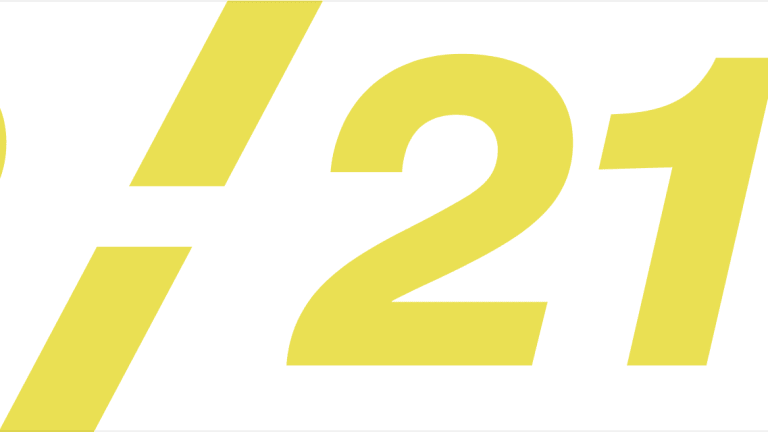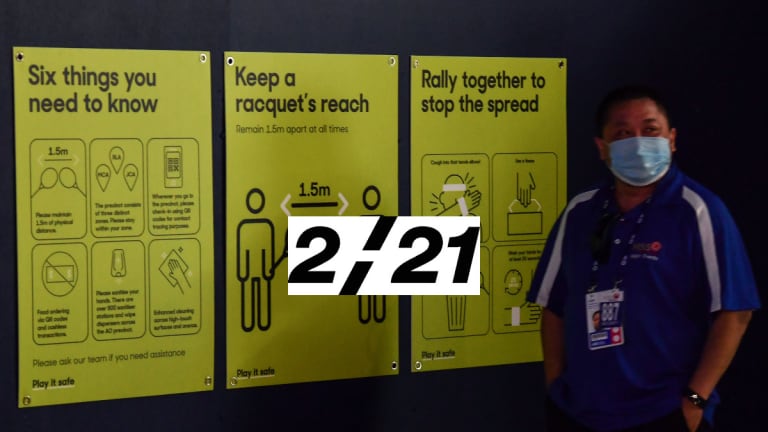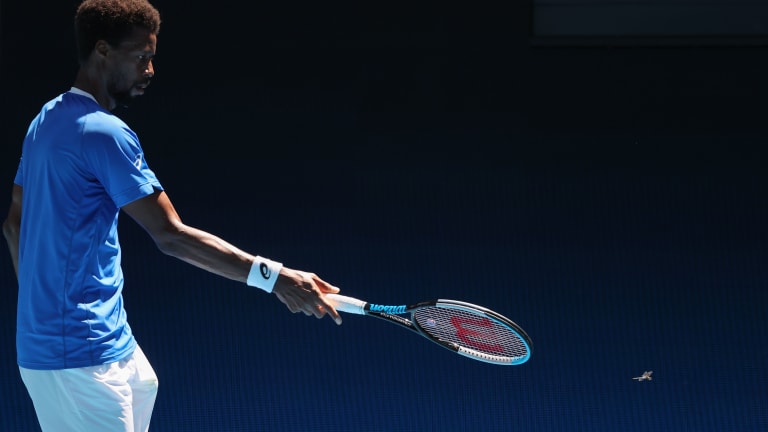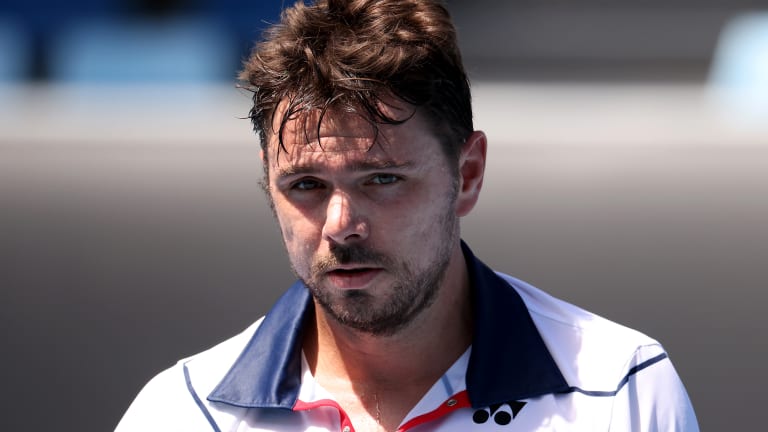The Rally: The 100-match smorgasbord in Melbourne—and hope for more
Feb 03, 2021Andrey Rublev reportedly adds Marat Safin to coaching team for clay-court season
By Baseline Staff Mar 30, 2025Doubles Partners: Asics and A.P.C. team up for one-of-a-kind tennis collection
By Jon Levey Mar 30, 2025PHOTOS: Aryna Sabalenka celebrates maiden Miami title with “lucky charm” goddaughter
By Baseline Staff Mar 30, 2025Novak's 99 Titles—a Djokovic deep dive: What they are, where they were won, when he did
By Liya Davidov Mar 30, 2025Novak Djokovic vs. Jakub Mensik: Where to watch, and who will win, their Miami Open final
By TENNIS.com Mar 30, 2025WATCH: Jessica Pegula steals Aryna Sabalenka's 'Marg-aryna' from Tennis Channel desk
By Baseline Staff Mar 30, 2025Aryna Sabalenka has now won 23 of her last 24 matches in the United States following Miami triumph
By John Berkok Mar 29, 2025Roger Goodell watches on as Aryna Sabalenka defeats Jessica Pegula in Miami final
By Associated Press Mar 29, 2025Aryna Sabalenka masters Jessica Pegula again to win Miami Open
By TENNIS.com Mar 29, 2025The Rally: The 100-match smorgasbord in Melbourne—and hope for more
From 100 or so matches to zero: looking back at a giant day in the sport, and looking ahead to an uncertain future.
Published Feb 03, 2021
Advertising
Nestled between January's summer swing of tournaments in Australia, and March's Sunshine Double in the U.S., February can be overlooked in tennis. But not in 2021, with the Australian Open's temporary move to the second and shortest month of the calendar. Beyond that, February is Black History Month, and also a pivotal time for the sport in its rebound from the pandemic.

The Rally: The 100-match smorgasbord in Melbourne—and hope for more
Advertising
To commemorate this convergence of events, we're spotlighting one important story per day, all month long, in The 2/21. Set your clock to it: it will drop each afternoon, at 2:21 Eastern Standard Time (U.S.).
Hi Joel,
Ernest Hemingway had his moveable feast in Paris. Yesterday, we might say that tennis had an immoveable feast in Australia. I don’t know what the record for the biggest order of play ever is, but the 100 or so matches that played out across 16 courts and 14 hours on Wednesday at Melbourne Park has to be in the running.
Dipping into what I could of this smorgasbord back in New York, my early reaction was that tennis, and sports, had triumphed again; that the effort it had taken to put on these tournaments during a pandemic had been worth it. But it looks like I may have spoken too soon.
The latest news is that a security guard at the Grand Hyatt in Melbourne, one of the tournament’s quarantine hotels, has tested positive for the coronavirus. This means Thursday’s schedule—beginning Wednesday night in the United States—has been canceled, and 500 to 600 people involved in the tournament, including many players, have to isolate until they record a negative test.
For now, the Australian Open is still scheduled to go on as planned, starting Monday, but it’s another reminder that we’re not going to be out of the woods with Covid until the last ball has been played Down Under. I think both of us have said that in 2021, we would be, to echo a cliché, “taking it one day at a time.” But I don’t think either of us anticipated that we could go from 100 matches to zero in the span of 24 hours.

The Rally: The 100-match smorgasbord in Melbourne—and hope for more
© AFP via Getty Images
Advertising
All photos from Getty Images
Back to our wild Wednesday. In the past, when I’ve been asked to give my thoughts on what I would change about the tennis schedule, I’ve usually begun with two things: (1) Lengthen the off-season by a month or two, so we are more eager for tennis to return; and (2) Start with a big, dual-gender special event—a tennis version of opening day—that lets people know the sport has returned.
To me, this week at Melbourne Park has shown that both of those ideas are theoretically valid. I was more eager for tennis to return on February 1 in Australia than I usually am when it comes back on January 1. And it has been fun to have everyone from both tours gather in one place, so you can see Novak Djokovic followed by Naomi Osaka followed by Stefanos Tsitsipas followed by Serena Williams and on and on. This particular smorgasbord, spread over half-a-dozen different tournaments, is probably too much of a good thing; I’m not even sure which player is in which competition. But I could see a more streamlined dual-gender event working well as a season kick-off.
Of course, as we know, making significant changes to the tennis schedule will always be something of a fantasy. For example, if you move the Australian swing to February, what do you do with the South American tournaments that are usually played during that month? Terminate them?
For now, I just hope Wednesday doesn’t turn out to be the end, rather than the beginning, of the 2021 season. What were your thoughts on this all-night affair, Joel? You may have had a chance to see more of it than I did from the West Coast.
Hi Steve,
Indeed, this current COVID scare is jolting. I feel terrible for everyone in Australia—not just those from the tennis community, but all in the country who have taken such major steps to stay safe. That kind of sequence—one day sunshine, the next day quarantined—creates quite an unsettling emotional climate. Let’s hope it’s only momentary and that all in Australia—again, including those who have nothing to do with the tennis—remain safe moving forward. Still, something tells me such occurrences are going to be part of our world and the tennis world for much of 2021.
As far as watching the action from Australia goes: It was terrific. From a smorgasbord, there will soon come a time to zero in on matches in more of a main course-like fashion. But the chance to graze yesterday was, if I may, delicious.
Between my TV and laptop, I bounced constantly, click to click, from court to court, not watching a single match start to finish. The upbeat Bethanie Mattek-Sands, commanding play versus crafty Barbora Strycova. Naomi Osaka, fighting off a three-set challenge from No. 371 Katie Boulter. Steady Elina Svitolina, also rallying from a set down to out-maneuver power-happy Jelena Ostapenko. Sofia Kenin, on the brink of defeat to Jessica Pegula, coming from a set and 1-4 down to win 5-7, 7-5, 6-2. Serena Williams, looking sharp for the second match in a row, beating fellow mother Tsvetana Pironkova, in straight sets:
The Rally: The 100-match smorgasbord in Melbourne—and hope for more
Advertising
Then there were the men—three-setters won by Alexander Zverev over Dennis Shapovalov, Alex Bolt versus Mackenzie McDonald, Stan Wawrinka past Mikhael Kukushkin. Toss in sharp efforts by Jan-Lennard Struff (who squeaked past Milos Raonic in two tiebreakers), Matteo Berretini, (who topped Gael Monfils in the ATP Cup), and, invariably, an up-and-down battle between Fabio Fognini and Benoit Paire, in the end won by Fognini, 6-1, 7-6 (2).
As I began watching each of these matches, I looked closely for signs of rust, lack of fitness, rigidity. But then, as the points went on, the realization hit: these are pros, highly skilled—and exceptionally fit (perhaps, we’ll see in time, some more than others). I saw a great deal of freshness, a delight from so many in being able to play one point after another. Colorful outfits, sparkling shot-making, dramatic moments, all set against the Australian sunshine.
My other confession: At this point I have no narrative stake in any of the many events going on at Melbourne Park. Who’s in what round? What stage are we at in the ATP Cup? How many points are on the line in one event compared to another? Right now, none of that matters. Let the feast continue.
Steve, what from the tennis has engaged you?
Joel,
Like you, I expected to see signs of rust last night. And like you, instead I saw signs of fresh energy and eagerness. But that always seems to be the case in Australia. I don’t think it’s an accident that so many classic matches have been played in Melbourne over the years, considering that the Australian Open comes right after the (brief) off-season, which is the only time the players have to rest and try to make improvements. This should go double in 2021, especially on the women’s side, where many players are making their first appearances since early October.
The other thing that was interesting to me about this week’s matches is how, even though it’s a new year, and even though it feels almost like a new era with the pandemic, so much stays the same in tennis.
At first, watching Zverev-Shapovalov, I thought Zverev had decided to be more proactive, the way so many of us wish he would be; but after a few games, I realized I was wrong and that he had settled back into his usual rallying groove. At first, watching Pegula build a big lead over Kenin, I thought the Buffalo native had gained the confidence to finally beat a Top 10 player; then she lost in three. When Osaka dropped the first set to Boulter, I thought Osaka may have lost a little of the rock-solid self-belief that she showed at last year’s US Open; then she rolled through the last two sets. Monfils got off to a flying start against Berrettini, until a dragonfly distracted him and he ended up losing in straights.

The Rally: The 100-match smorgasbord in Melbourne—and hope for more
© AFP via Getty Images
Advertising
We talk a lot about what players can do to transform their games and fulfill their potential, but in truth the same strengths and flaws continue to reveal themselves. At a certain point, to paraphrase the late NFL coach Dennis Green, you are who we thought you were.
That are exceptions, of course, like Wawrinka, who won his first major when he was nearly 30. As you said, it was good to see Stan’s backhand again last night, and it’s good to see the players being themselves, flaws and all.
Did anyone catch your eye for what they might be doing differently, or what they might have improved, Joel?
Steve,
I agree with you that tennis players are pretty much who they are—that is, when we’re talking about the pros. All of them have climbed right to the top of the mountain. Each has darn good possession of his or her personal range of weapons. Each also brings a certain mentality to competition. Exhibit A came yesterday: the odd mix of emotions guaranteed to surface when such volatile competitors as Fognini and Paire take the court. These two are vivid testimony to tennis’ lure as a sport for individuals. Oy.
So it’s not easy to tell after these early days of competition if a particular player is doing something different. I think at the pro level, changes are usually incremental and also only most apparent over the long haul. Sometimes this can happen over the two weeks of a major, as we saw four years ago in Australia, when Roger Federer trotted out his improved backhand—and deployed it in new ways. But mostly, these changes become more clear over the long haul (such as Rafael Nadal’s increased penchant for volleying).
How fitting, Steve, that with all eyes on Australia, that you mentioned Wawrinka and his late-career ascent. I vividly recall being in Melbourne in 2013, when he lost a heartbreaker of a round-of-16 match to Novak Djokovic, 12-10 in the fifth. A year later they met in the quarters, but this time Wawrinka won it, 9-7 in the fifth—and then went on to win the tournament, beating Nadal in the finals.

The Rally: The 100-match smorgasbord in Melbourne—and hope for more
© Getty Images
Advertising
I suppose logic would say that Wawrinka was playing better in 2014. But discerning how or why is complicated. Improved fitness? Enhanced technique? Better tactics? A bit better execution at the right times? And what do terms like “confidence” and “belief” really mean, when two players each have such tremendous skills?
That said, the lengthy exiles from competition over the last year have given many players an opportunity to enhance their games. While I suspect the vast majority mostly devoted themselves heavily to fitness, I’m in step with you in wanting to see which have looked to refine techniques and tactics. Who has improved their second serve? Who is looking to come net more with a refined volley technique? Might some have studied videotapes of their matches and those of their rivals to see how they might gain an edge with court positioning, variations in speed and spin, or any other strategic shifts?
A common phrase I hear from players, parents and coaches: “today’s game.” But why play the game of today? Better instead: build the game of tomorrow, so you can beat the game of today. I’m crossing my fingers that we might see some signs of that in Melbourne this month. But how and when they’ll surface is a mystery.

The Rally: The 100-match smorgasbord in Melbourne—and hope for more